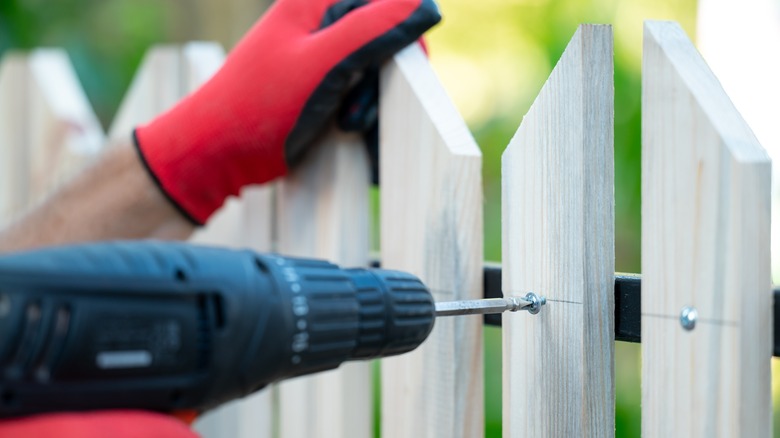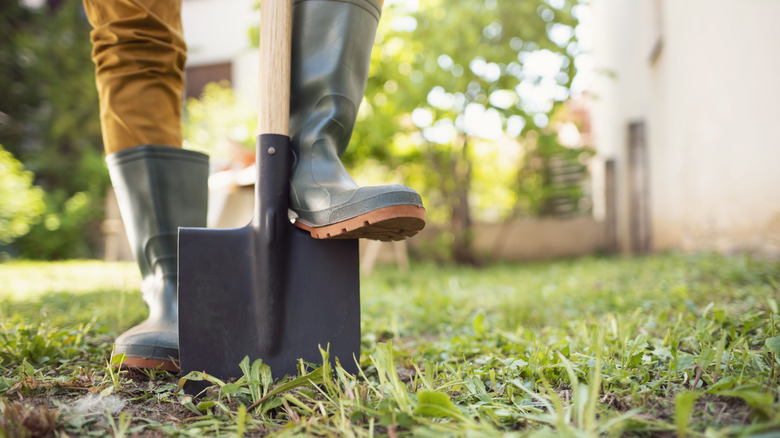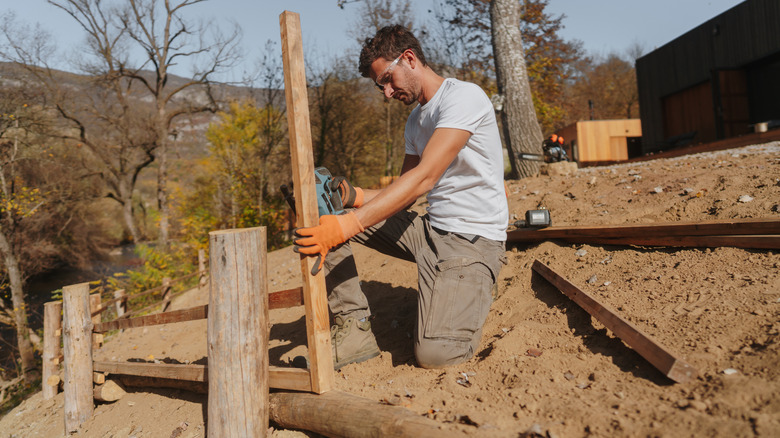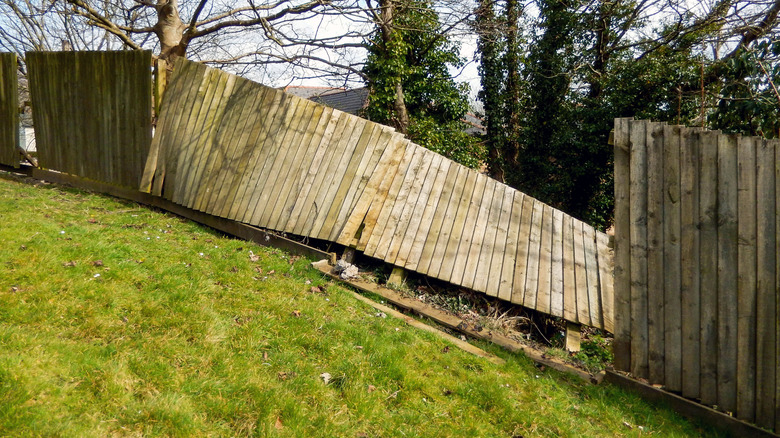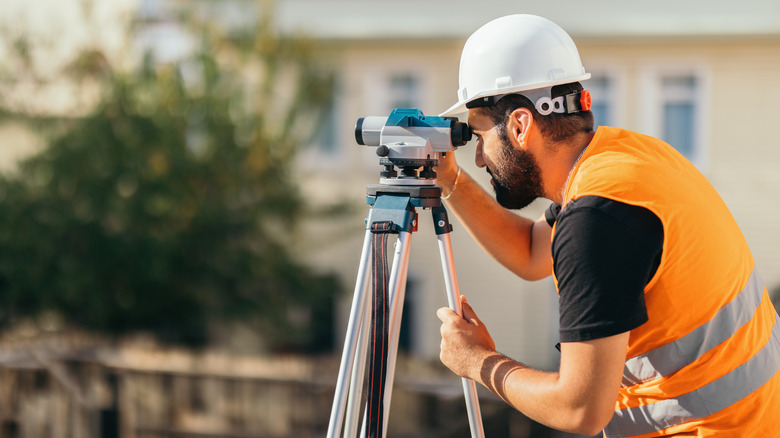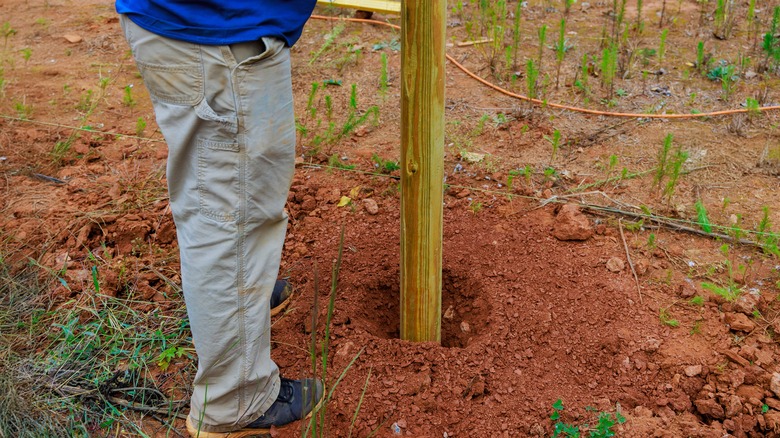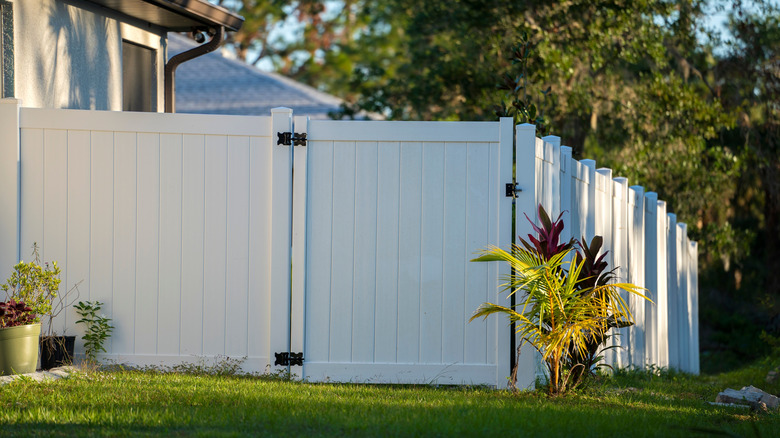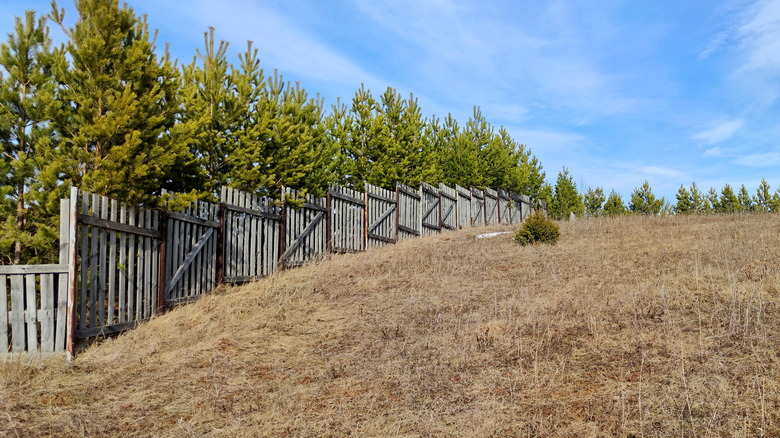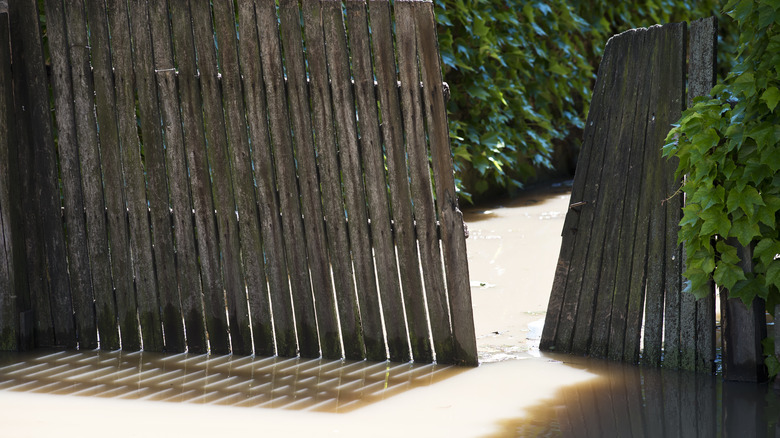Mistakes Everyone Makes When Installing A Fence
There are many reasons you may be considering building a fence in your yard. You might be seeking a safe play area for your children — or a new pet. You might also be looking for a bit more privacy from your neighbors or seeking to keep unwanted visitors from wandering in your yard. Whether you're looking to hire a professional company to install the fence or are planning to take it on as a DIY project, you want to make sure that it goes up properly and is built to last for many years to come.
Unfortunately, many homeowners (or the contractors they hire) often make mistakes when installing a fence. These mistakes have the potential to lead to a whole host of issues, including drainage problems, upsetting the neighbors, getting into trouble with a homeowners association, or increasing the chances that the fence will sustain damage from the elements. To help us learn more about the mistakes that should be avoided, House Digest spoke exclusively with several home and landscaping experts. Here's how to avoid falling victim to some common blunders.
Failing to get a permit can lead to legal issues
Before you finalize your plans to install a fence on your property, don't forget to contact your city or county office to request a permit. In an exclusive interview with House Digest, Co-Owner of Bonsai Builders, Kristin Hintlian, notes that many people mistakenly skip this step. She explains, "Many overlook this, assuming it's a minor detail, but not having the proper permits can lead to legal complications, fines, or being forced to dismantle the fence."
Once you have the fence up, the last thing you'll want is an official telling you it needs to come back down. You also aren't going to want to pay any fines or suffer other consequences because you weren't proactive in securing a permit before it was installed. "I always advise checking with local authorities to ensure compliance with all regulations, which not only protects against legal issues but also ensures safety standards are met," says Hintlian.
Similarly, if your neighborhood has an HOA, don't forget to request approval from them as well. Some HOAs may have rules in place about the height, design, or color of a fence. And you won't want to suffer any repercussions for not following these guidelines.
Not checking for utility lines before digging can be dangerous
Before you, or the fencing company you hire, start putting up your new fence, don't make the mistake of digging without considering what may be beneath the ground. In an exclusive interview with House Digest, Steve Schumacher, the owner of Boston Landscape Co. explains that people often forget to check for utility lines before they dig the holes for the posts. "This can lead to significant safety risks, such as hitting gas or water lines, resulting in expensive repairs and potential service disruptions," he explains.
Instead, plan ahead and take the necessary measures to determine whether there are any electrical, cable, or other utility lines where you want to install the fence. Fortunately, there is a national number to call before you dig any holes in your lawn. Dialing 811 will connect you with a local resource to look for the utility lines on your property. They can come out and mark the location of any lines, helping you or the installers know which areas of the lawn to avoid when setting up the fence.
Neglecting to consider the soil type can result in instability
Did you know that the type of soil in your yard should be considered before installing a fence? If you didn't, you're certainly not alone, and we've hopefully helped you avoid a potentially catastrophic mistake. During an exclusive interview with House Digest, Sal Musto, the owner of SalCorp Landscaping & Construction, explained that the type of soil you have and how well it drains may result in stability problems with the fence over time. "For example, in areas with clay soil, which we have encountered around Walpole, MA, the ground can expand and contract significantly, affecting post integrity. Setting fence posts without considering these factors can result in leaning or collapsing fences," he says.
To avoid this problem, Musto recommends taking an assessment of the composition of your soil along with the moisture and drainage conditions. If you don't have proper drainage, he shares how a little gravel can help when installing the fence. "A technique I find effective is using gravel at the base of the post holes to improve drainage and reduce freeze-thaw damage," Musto says. As an added bonus, the additional drainage can prevent your posts from sitting in moist soil which can lead to the wood rotting.
Failing to consider wind load may lead to a poor design
Strong winds have the potential to cause serious damage to a fence. This damage will be more serious if you don't consider wind load before installing the fence. "'I've seen cases where fences failed because they weren't designed to withstand high winds common in open landscapes," says Musto. If you live in such an area, then you should take that into account when purchasing materials for your fence or planning it out with a fence-building company. Musto recommends "design[ing] the fence with more substantial posts and rails and consider[ing] windbreaks or designs that allow airflow."
Bob Berriz, the owner of Berriz Design and Build, notes that fences in open areas aren't the only ones that may be threatened by high winds. If you live near the coast, this is also something you should be aware of. In an exclusive interview with House Digest, he said, "In one case, our coastal projects demanded reinforced posts and angled slats to reduce wind impact. Consider the wind patterns in your area when selecting fence design and materials to ensure lasting durability."
Panel designs like picket, slatted, or lattice fencing tend to do best in windy areas as they have gaps to allow strong gusts to pass through easily. It's also important that posts be placed deeper and closer together in particularly windy areas. After it's built, inspect your fence regularly, especially the posts, and repair any issues quickly. Small problems can quickly lead to major structural integrity issues in windy conditions.
Not looking at property lines first could lead to improper fence placement
Many people assume they know where their yard ends and their neighbor's yard begins. But are you 100% confident in the exact location of your property line? If you haven't had it marked recently, you should find the property line of your home before you begin the installation process for your fence.
Joe Gerrior, the owner of Gerrior Masonry & Landscape Construction Corp., told House Digest in an exclusive interview that it's important to install the fence abiding by any rules with regard to that property line. He explains, "In my experience, it's crucial to check for any easements or restrictions and to have a property survey done prior to installation. This ensures the fence is legally compliant and positioned correctly."
If you skip the step of verifying the location of the property line, you may need to have it removed and reinstalled within the limits of the line. While you can build right up to the limits in some areas, others require a few inches of space between the edge of the fence and the line. To verify the rules in your area, you can reach out to your county clerk, a title company, or any zoning authorities that govern your property.
Not considering frost heave may result in cold-weather damage
If you live in an area where it gets cold in the winter, you must consider frost heave before installing your fence. Frost heave occurs in the regions of the country where the ground freezes over the winter. The frozen conditions don't just occur right at the surface, instead they can reach several feet beneath the surface. The ice in the soil causes frost heave, or the upward or outward motion of anything in the ground. "If posts aren't set deep enough or properly secured with concrete, frost heave can push them out of alignment, causing the fence to lean or sag," explains Gerrior.
To avoid this problem, you need to make sure that the holes for the posts are dug deep enough below the surface. Gerrior recommends digging to a minimum of 42 inches, or at least one-third of the entire post length. He also suggests using concrete to stabilize the posts to help ensure that they maintain their position for many years to come.
Choosing the wrong materials could cause a number of issues
It is important to not only choose a fence that is right for your family's lifestyle, but you should also consider how any fencing materials will look with your home's facade. Regulations are another big consideration, as some HOAs or municipalities only allow certain materials like white vinyl or black wrought iron. It's also important that your fence is made from materials that are suitable for the climate where you live. "I've seen untreated wooden fences crumble in rainy climates after just a few years because they weren't built to handle constant moisture. On the other hand, metal fences in coastal areas can rust quickly from salt in the air," Andriy Boyko, a seasoned handyman of A.O. Handy Inc., told House Digest during an exclusive interview.
To avoid a similarly catastrophic outcome, keep the climate of your region in mind when shopping for fencing materials. "In wet or humid areas, pressure-treated wood resists moisture better, or you could go with vinyl, which is water-resistant and low-maintenance," says Boyko. If you live in a desert region or anywhere else that is very hot and dry, he recommends a composite or metal fence that has a protective outer coating. Once you've selected the best material, Boyko says, "Don't forget to add a weatherproof stain or sealant to wood or a rust-proof coating to metal for extra durability."
Ignoring the slope of the ground may leave gaps and look sloppy
Boyko warns that trying to build a fence in a straight line over a sloped yard can create problems. Beyond not delivering a professional look, it may also leave gaps between the base of the fence and the ground where unwanted critters can enter your yard or where your own furry friends could escape.
Instead, Boyko says to match the design of the fence to the terrain of your yard. "A raked fence follows the ground's natural slope, keeping a uniform gap along the bottom. A stepped fence, on the other hand, creates level sections that step down incrementally with the slope." Since Boyko notes that both of these options are both functional and professional-looking, you can use your personal preferences to decide which privacy fence design is right for your sloped backyard.
No matter which design you choose, you'll want to make sure your posts are installed straight with a level, checking them often until the concrete foundation dries. If you choose a raked design, you'll need to purchase or pre-order custom panels made to the specific angle of your yard's slope. So, if you'd like to use standard panels, a stepped fence is your best bet.
Not planning for drainage can lead to posts failing
If you want to build the perfect fence, you must consider drainage. Boyko explains, "Water pooling around wooden posts can lead to rotting, while metal posts can corrode. Even vinyl can suffer if the ground stays waterlogged, as the shifting soil can cause posts to lean." The last thing you want is for your new fence to start leaning or rotting because of a drainage issue that could have been prevented.
To avoid these potential drainage-related problems, Boyko explains that you'll want to think about where the water will go when it rains. Identify any areas where water is likely to pool after a rainstorm. "If a post has to go in a low-lying spot, fill the bottom of the hole with gravel to improve drainage before adding concrete. This will help water flow away from the post and keep the base dry," says Boyko. If you live in a very wet region, he also recommends considering a French drain to help water drain and prevent it from causing damage to the fence.
If you plant any landscaping along your fence, make sure to trim it back regularly and clear debris to allow for adequate airflow and ventilation. Also, focus on adding plants with low water needs to the area. That way, you don't have to water them often, adding excess moisture to your fence area.
